High Concentration Ascorbic Acid May Adversely Affect Breast Cancer Metastasis and Disease Progression
Nicole Hoffman, Brandi Sweet, Julie Wagner, Akina Fujimoto, Stephanie Tuft, Dr. Julia Oxford
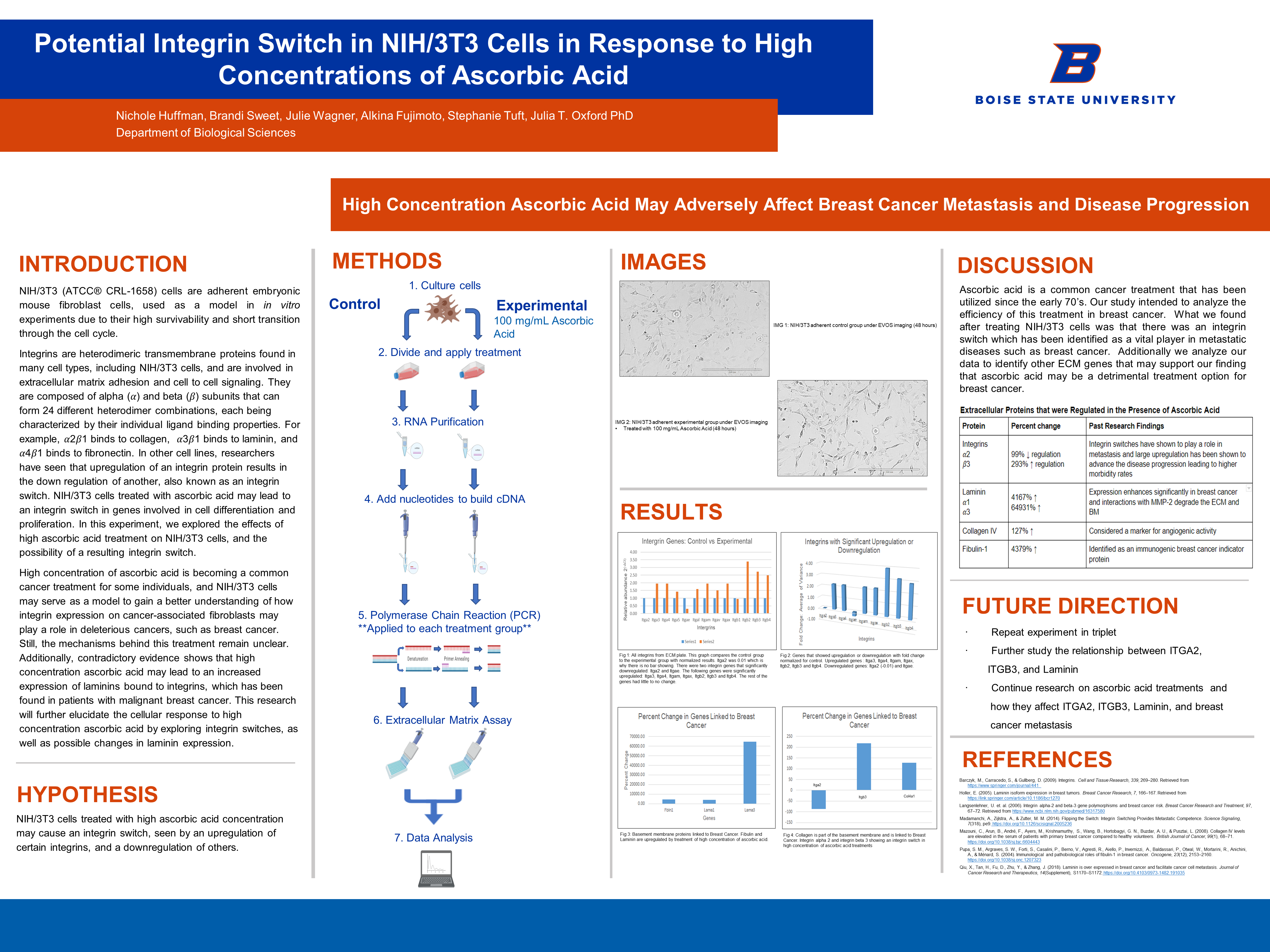
Introduction
NIH/3T3 (ATCC® CRL-1658) cells are adherent embryonic mouse fibroblast cells, used as a model in in vitro experiments due to their high survivability and short transition through the cell cycle.
Integrins are heterodimeric transmembrane proteins found in many cell types, including NIH/3T3 cells, and are involved in extracellular matrix adhesion and cell to cell signaling. They are composed of alpha () and beta () subunits that can form 24 different heterodimer combinations, each being characterized by their individual ligand binding properties. For example, 21 binds to collagen, 31 binds to laminin, and 41 binds to fibronectin. In other cell lines, researchers have seen that upregulation of an integrin protein results in the down regulation of another, also known as an integrin switch. NIH/3T3 cells treated with ascorbic acid may lead to an integrin switch in genes involved in cell differentiation and proliferation. In this experiment, we explored the effects of high ascorbic acid treatment on NIH/3T3 cells, and the possibility of a resulting integrin switch.
High concentration of ascorbic acid is becoming a common cancer treatment for some individuals, and NIH/3T3 cells may serve as a model to gain a better understanding of how integrin expression on cancer-associated fibroblasts may play a role in deleterious cancers, such as breast cancer. Still, the mechanisms behind this treatment remain unclear. Additionally, contradictory evidence shows that high concentration ascorbic acid may lead to an increased expression of laminins bound to integrins, which has been found in patients with malignant breast cancer. This research will further elucidate the cellular response to high concentration ascorbic acid by exploring integrin switches, as well as possible changes in laminin expression.
Hypothesis
NIH/3T3 cells treated with high ascorbic acid concentration may cause an integrin switch, seen by an upregulation of certain integrins, and a downregulation of others.
Methods
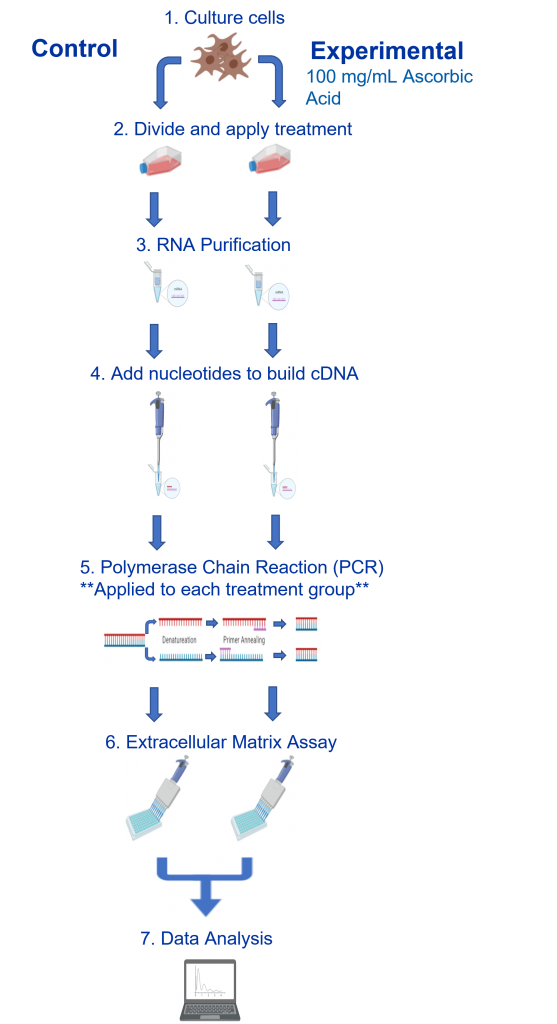
Experimental group 100mg/mL ascorbic acid. For both the control and experimental group:
- Culture Cells
- Divide and apply treatment
- RNA purification
- Add necleotides to build cDNA
- Polymerase Chain Reaction (PCR) **applied to each group**
- Extracellular Matrix Assay
- Data Analysis
Images
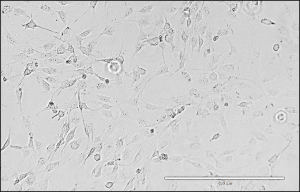
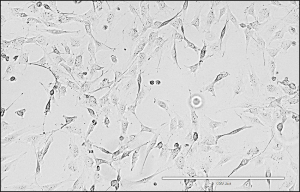
Treated with 100 mg/mL Ascorbic Acid (48 hours)
Results
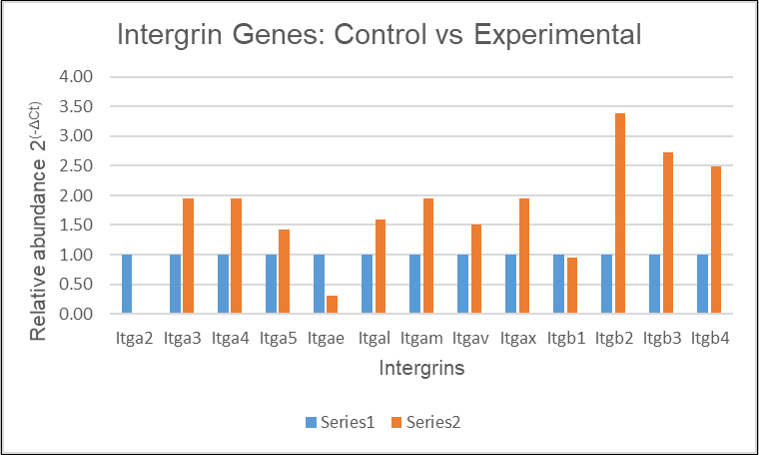
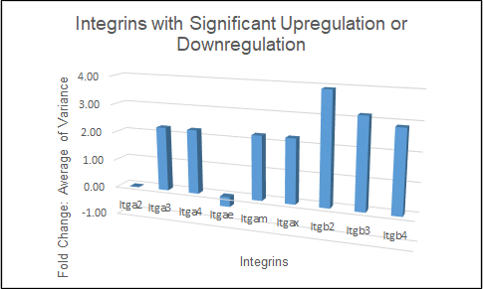
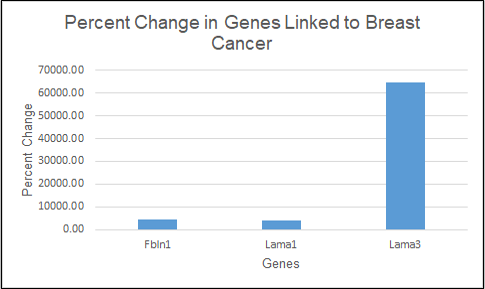
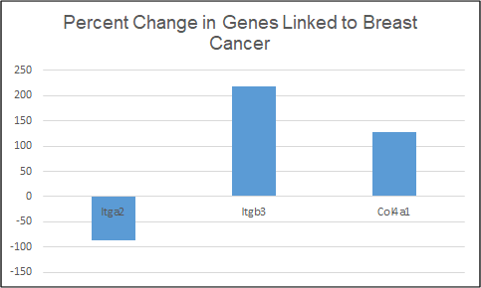
Discussion
Ascorbic acid is a common cancer treatment that has been utilized since the early 70’s. Our study intended to analyze the efficiency of this treatment in breast cancer. What we found after treating NIH/3T3 cells was that there was an integrin switch which has been identified as a vital player in metastatic diseases such as breast cancer. Additionally we analyze our data to identify other ECM genes that may support our finding that ascorbic acid may be a detrimental treatment option for breast cancer.
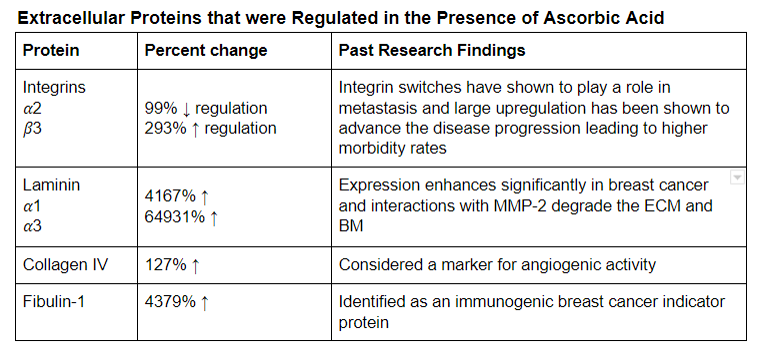
Future Direction
- Repeat experiment in triplet
- Further study the relationship between ITGA2,
ITGB3, and Laminin - Continue research on ascorbic acid treatments and
how they affect ITGA2, ITGB3, Laminin, and breast
cancer metastasis
References
- Barczyk, M., Carracedo, S., & Gullberg, D. (2009). Integrins. Cell and Tissue Research, 339, 269–280. Retrieved from https://www.springer.com/journal/441
- Holler, E. (2005). Laminin isoform expression in breast tumors. Breast Cancer Research, 7, 166–167. Retrieved from https://link.springer.com/article/10.1186/bcr1270
- Langsenlehner, U. et. al. (2006). Integrin alpha-2 and beta-3 gene polymorphisms and breast cancer risk. Breast Cancer Research and Treatment, 97, 67–72. Retrieved from https://www.ncbi.nlm.nih.gov/pubmed/16317580
- Madamanchi, A., Zijlstra, A., & Zutter, M. M. (2014). Flipping the Switch: Integrin Switching Provides Metastatic Competence. Science Signaling, 7(318), pe9. https://doi.org/10.1126/scisignal.2005236
- Mazouni, C., Arun, B., André, F., Ayers, M., Krishnamurthy, S., Wang, B., Hortobagyi, G. N., Buzdar, A. U., & Pusztai, L. (2008). Collagen IV levels are elevated in the serum of patients with primary breast cancer compared to healthy volunteers. British Journal of Cancer, 99(1), 68–71. https://doi.org/10.1038/sj.bjc.6604443
- Pupa, S. M., Argraves, S. W., Forti, S., Casalini, P., Berno, V., Agresti, R., Aiello, P., Invernizzi, A., Baldassari, P., Otwal, W., Mortarini, R., Anichini, A., & Ménard, S. (2004). Immunological and pathobiological roles of fibulin-1 in breast cancer. Oncogene, 23(12), 2153–2160. https://doi.org/10.1038/sj.onc.1207323
- Qiu, X., Tan, H., Fu, D., Zhu, Y., & Zhang, J. (2018). Laminin is over expressed in breast cancer and facilitate cancer cell metastasis. Journal of Cancer Research and Therapeutics, 14(Supplement), S1170–S1172. https://doi.org/10.4103/0973-1482.191035
Additional Information
For questions or comments about this research, contact Nichole Hoffman at nicholehoffman@u.boisestate.edu.